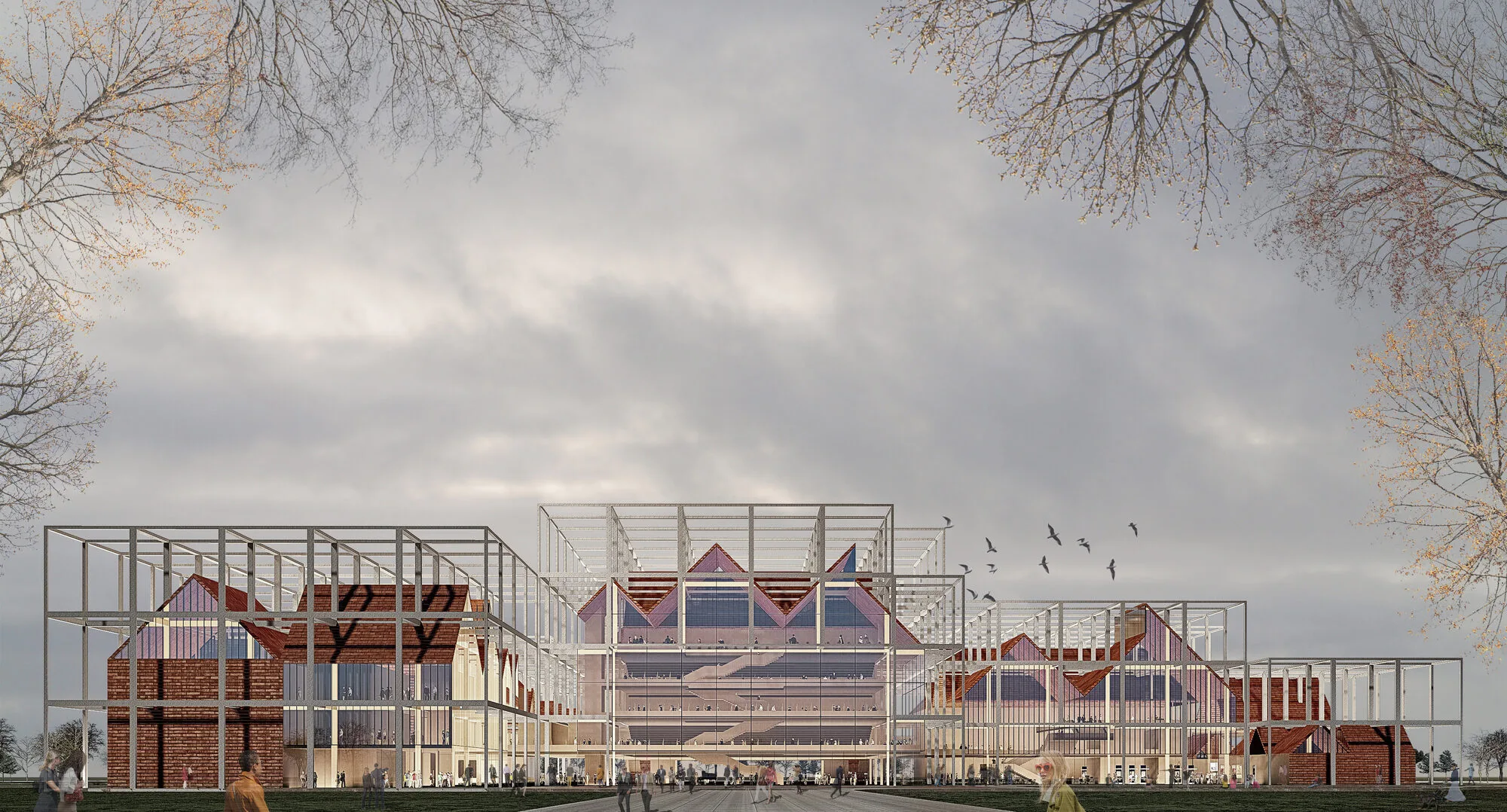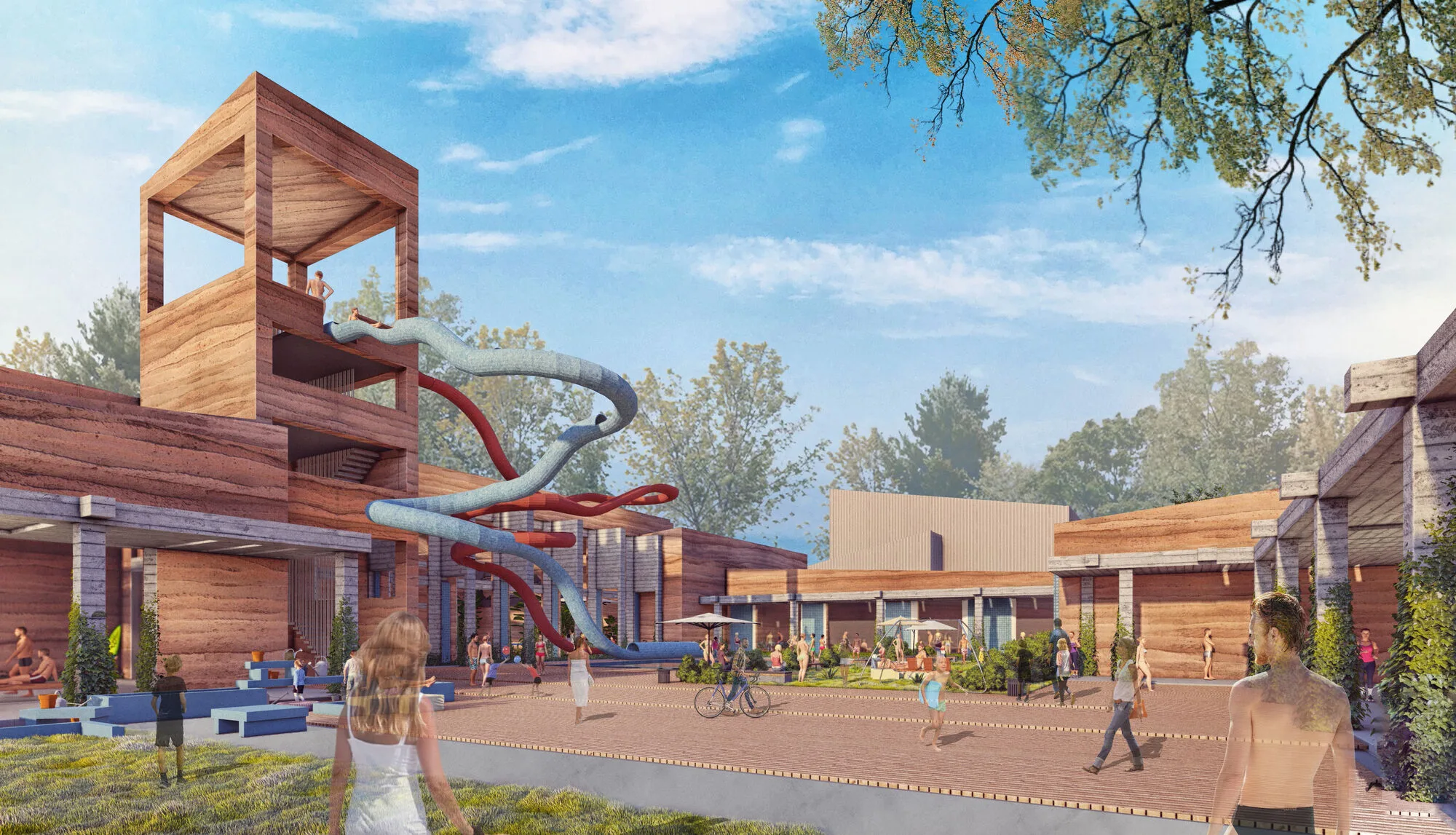
New Municipal SPA For Krnov
Krnov SPA
Spa and its applications, which also represents health coming from water, and its applications have been in the lives of people since ancient times. Today, spa spaces often work together with many spaces and functions. Spa facilities can be defined as places where people get away from the stresses, intense tempos, and the chaos of the city. These requirements of the spa users have also affected how approaches to the spas, multifunctional and alternative spaces have been designed nowadays.
New Municipal SPA For Krnov
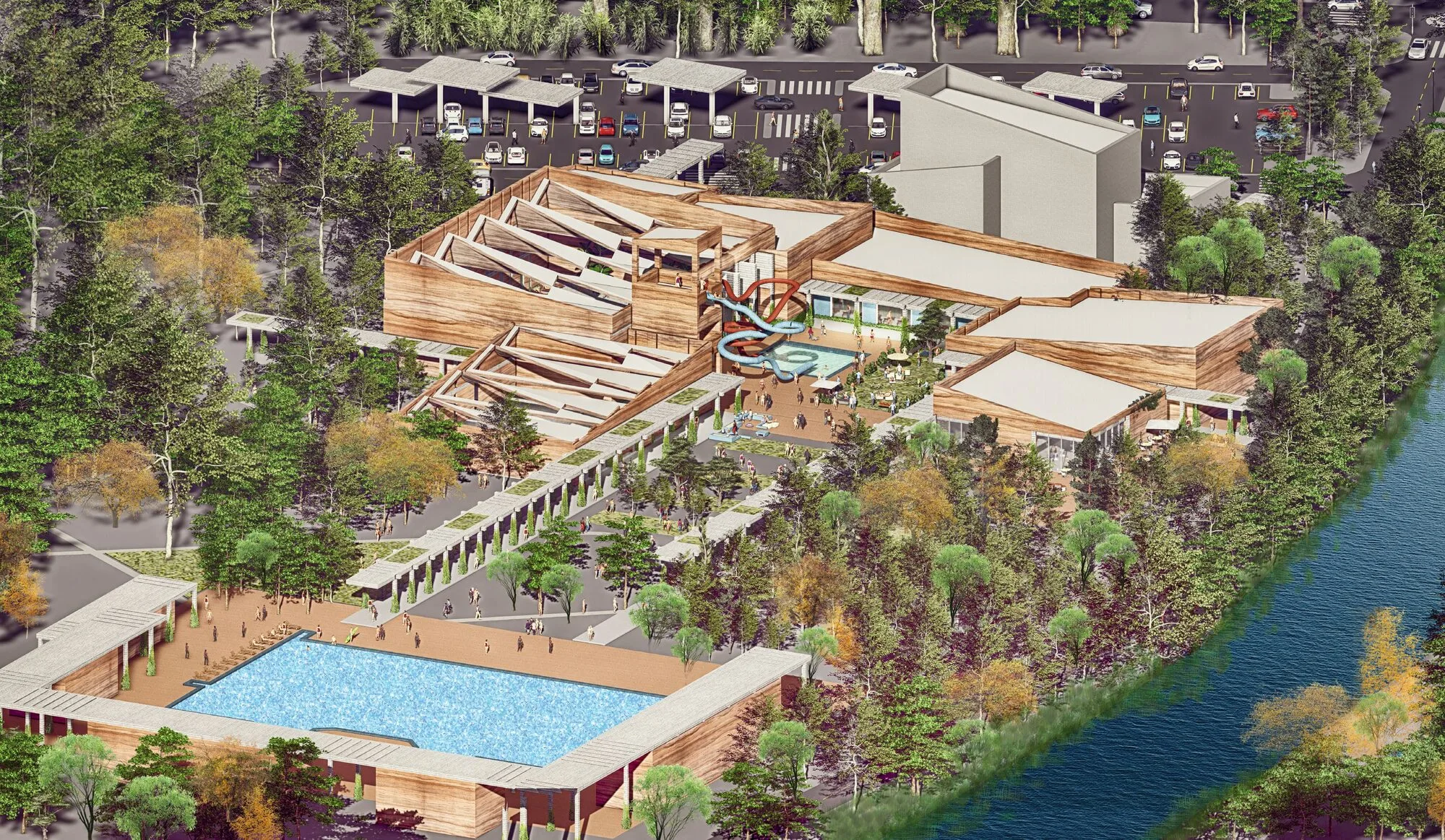
When the Krnov Spa Facility design competition data and the area are examined, it is seen that it includes many parameters. Looking at the area from the upper scale, the project site located in Krnov, a rural town in Czechia, is close to the Polish border. The project area is perceived as a very defined zone with 45 of the central transportation axes of the town to the east, the Opava river to the south and a highway to the north. The region where the project area is located has been thought and designed on site, independently of the general architectural understanding of Czechia. It has an indoor Olympic swimming pool, indoor entertain- ment pool, sauna world, entrance, Gym, cafe, parking lot and an axis that strengthens its connection with the existing pool. These defined places exist with its auxiliary spaces (wet volumes, dressing rooms), which provides an integrity by incorporating and protecting the existing green texture it into itself.
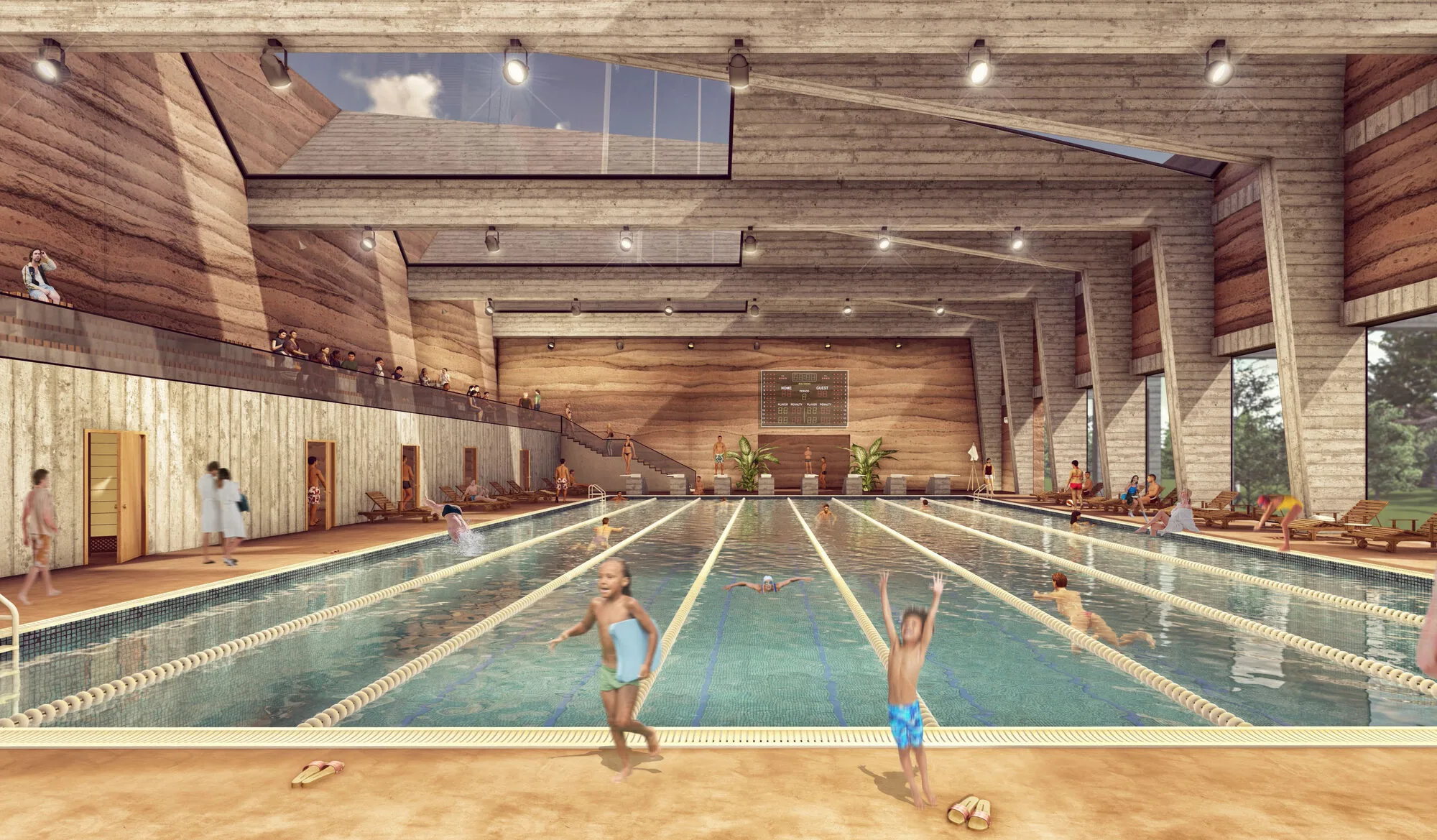
Architectural and Urbanistic Solution
The architectural setup of the Krnov Spa Facility was established to create interrelated spaces by contem- plating the environmental equipment, local materials, and economical aspects. With this in mind, particular- ly the existing outdoor swimming pool was handled in this thread by using above methods of interconnecting spaces. The complex consists of the entrance, dressing section, gym, indoor swimming pool, indoor resting pool, children’s pool, sauna, food and beverage area, water tower, outdoor swimming pool and technical volume units. While producing the settlement decisions at the scale of the site plan, a parking lot has been created in such a way that there will be parking spaces for 200 normal vehicles, 40 for bicycles and motor- cycles, and parking spaces for other vehicles (such as buses and caravans) to work with the building.
The integrity in the site plan is allotted into the current circulation routes. It is aimed to develop the spatial function perceptions of the users. The entrance mass and its space have been clarified in the design and the orientation of the users has been ensured. The eaves extending towards the parking lot acts as an axis that highlights the orientation between the open space (car park) and the closed space (entrance). Within the entrance mass, there are circulation areas that provide access to information, registration, ticket issuance and resting functions.
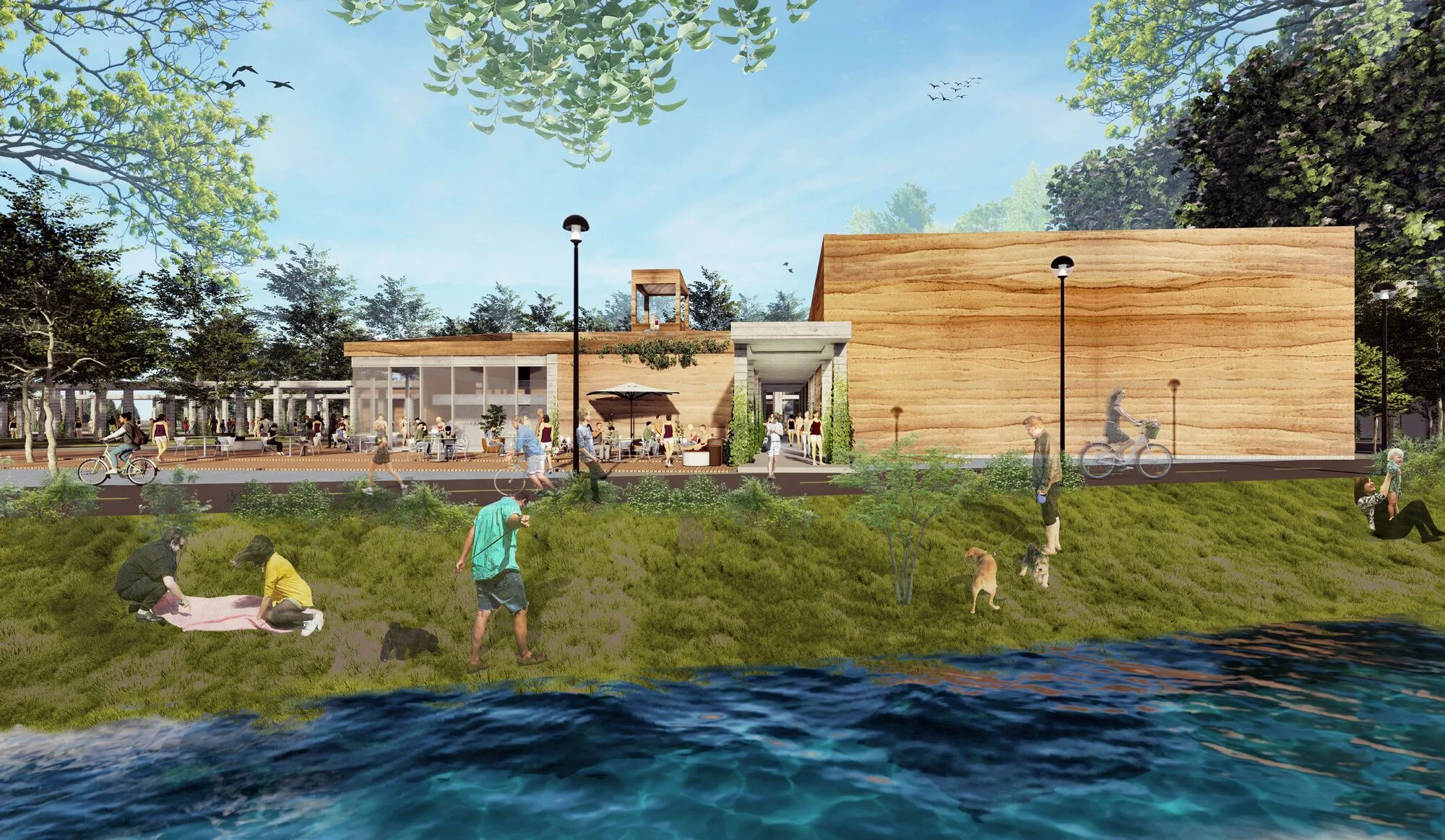
When the project is first examined at the site plan scale, it is seen that the effect of the design decisions made at the beginning of the project is clearly implemented. These decisions are the mass settlement that connects linearly with the open pool on the neighbouring parcel, the gradual settlement system that estab- lishes a relationship with the highway from the North and the Opava river from the south in terms of level and accessibility according to the topographical and environmental data of the land, and the gradual settlement system that draws the route of the users within the project area and at the same time is open. Reinforced concrete eaves, which draws a defined axis for the people heading from the pool and the parking lot or who will use these spaces, are shaped ac- cording to the density of the green texture and accordingly, to ensure that they are in the design by making retreats on the façade.
There is a gym that works directly with the entrance mass and a locker area which includes the private lockers for gym users. Since the Gym is recom- mended to work as a semi-private facility within the Spa Cen- tre, it is positioned so that only people who want to use this space can directly access it from the entrance mass. The Gym is located at the -3.50 level with its changing rooms, counselling, office, and units so that it can also work independently from the facility. Space height: Considering ergonomic conditions and ventilation, it was designed to be 5.20 m. In addition, the technical volumes required for the facility have been solved at the same level with the Gym.
The changing rooms are associated with the entrance mass considering the users in the pool and the facil- ity. Since it is one of the main spaces, it is once again highlighted in mass movements and the space itself is expressed as a box. The places directly connected with this area are the Sauna World and the Indoor Swimming Pool.
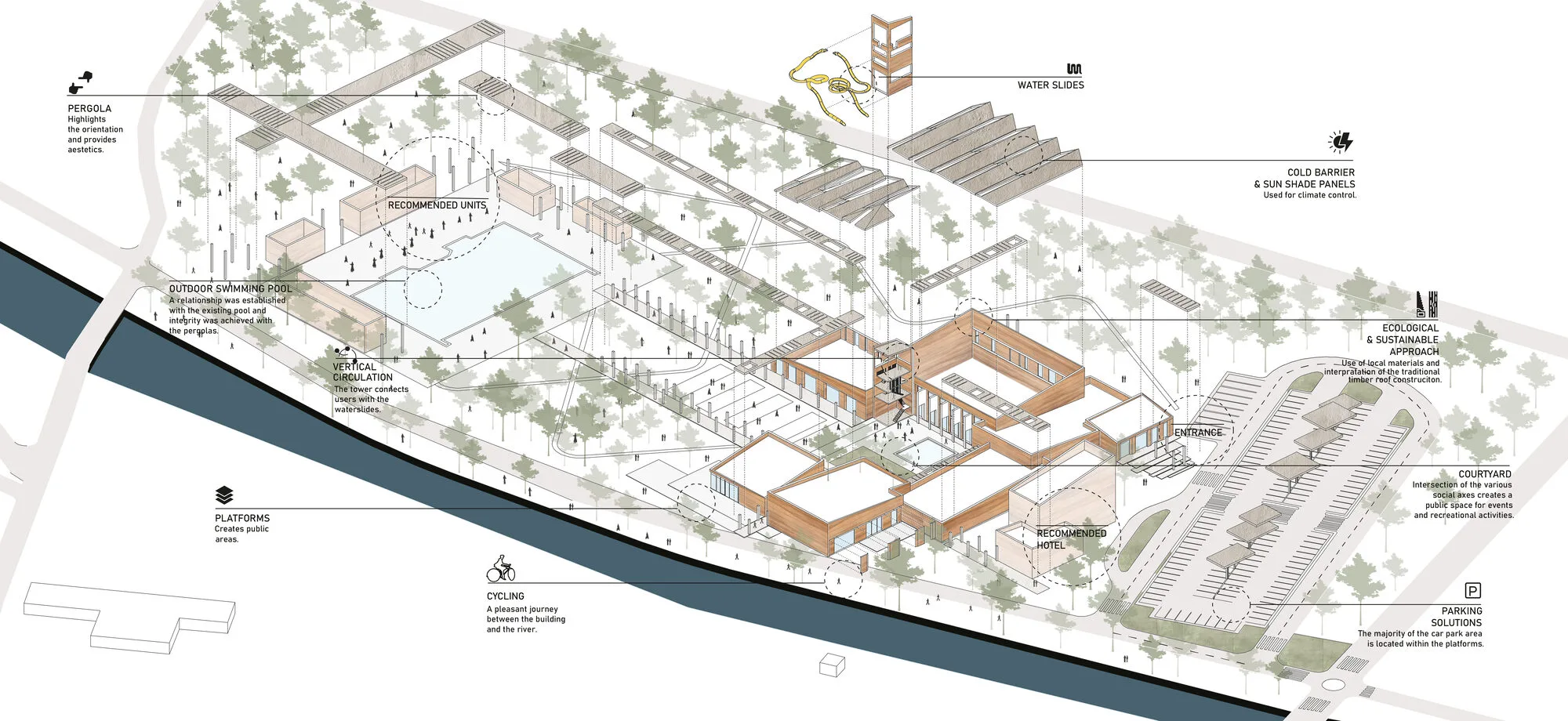
Urban Scale Approach & Public Solutions
Upper Scale
As soon as we approach the design field from the upper scale, Krnov; Is located between the Moravian and Silesian regions of Czechia, near the Polish border. Classical architectural style, which is dominant in most regions of Czechia; Is also heavily influenced in this part of the country. The town also contains a dense green texture and offers people historical and natural treasures together. In this context, when approaching to the project area; Its location is defined by the road axis in the north and the Opava river in the south. Plot borders are framed by dense tree colonies.
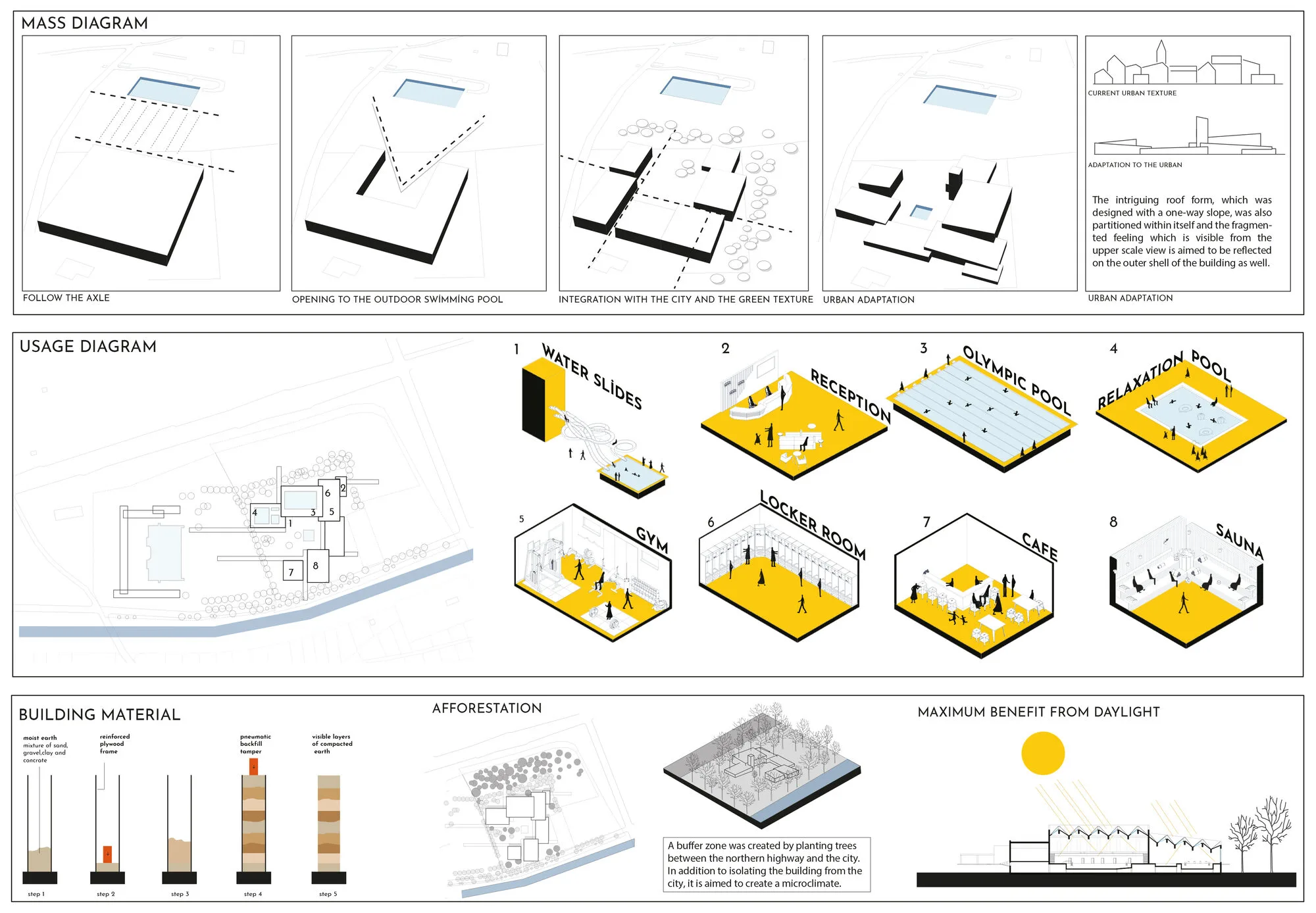
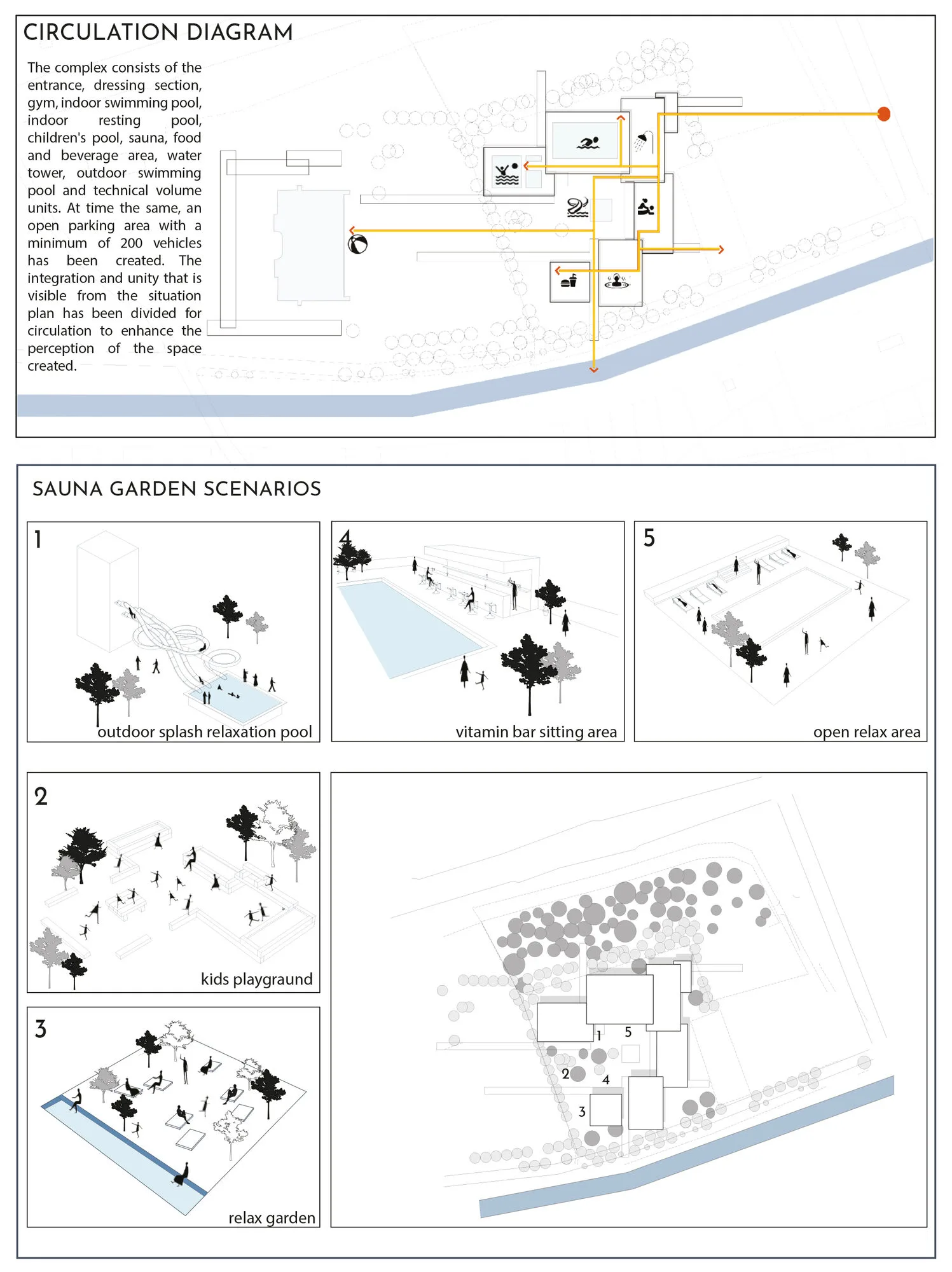
Partial Perspective
The project area was not only designed in itself, but also connected with the existing outdoor swimming pool facility located on its side plot by establishing a linear connection which is proposed and aimed to work together.
In addition to this concept, the climatic data presented by the current location of the project area were analysed and since the parcel has a continental climate structure and the winters are harsh and the number of sunny days is low, the concept structure is designed and rethought to maximize the surface area within the project site. However, the closed areas created in the site plan are arranged in such a way as to form semi-open inner gardens by segregating or merging from each other from place to place.
Later, the fragmented and defined spaces were placed on the situation according to certain features and associated with each other. Considering the design from the upper scale the existing C form formed by the current outdoor swimming facility attracted our attention. Therefore, the newly designed ‘’Krnov Spa Facility’’ design was designed according to the C form, referring to the existing design, and the rectilinear connection between the two facilities was strengthened and covered each other.
Taking into consideration the topographic features of the land, the difference in the altitude between the road axis limiting it and the Opava River was noticed. The structure designed on the basis of this is also staggered in the section, and the users’ structure is animated not only in the horizontal plane, but also in the vertical plane.
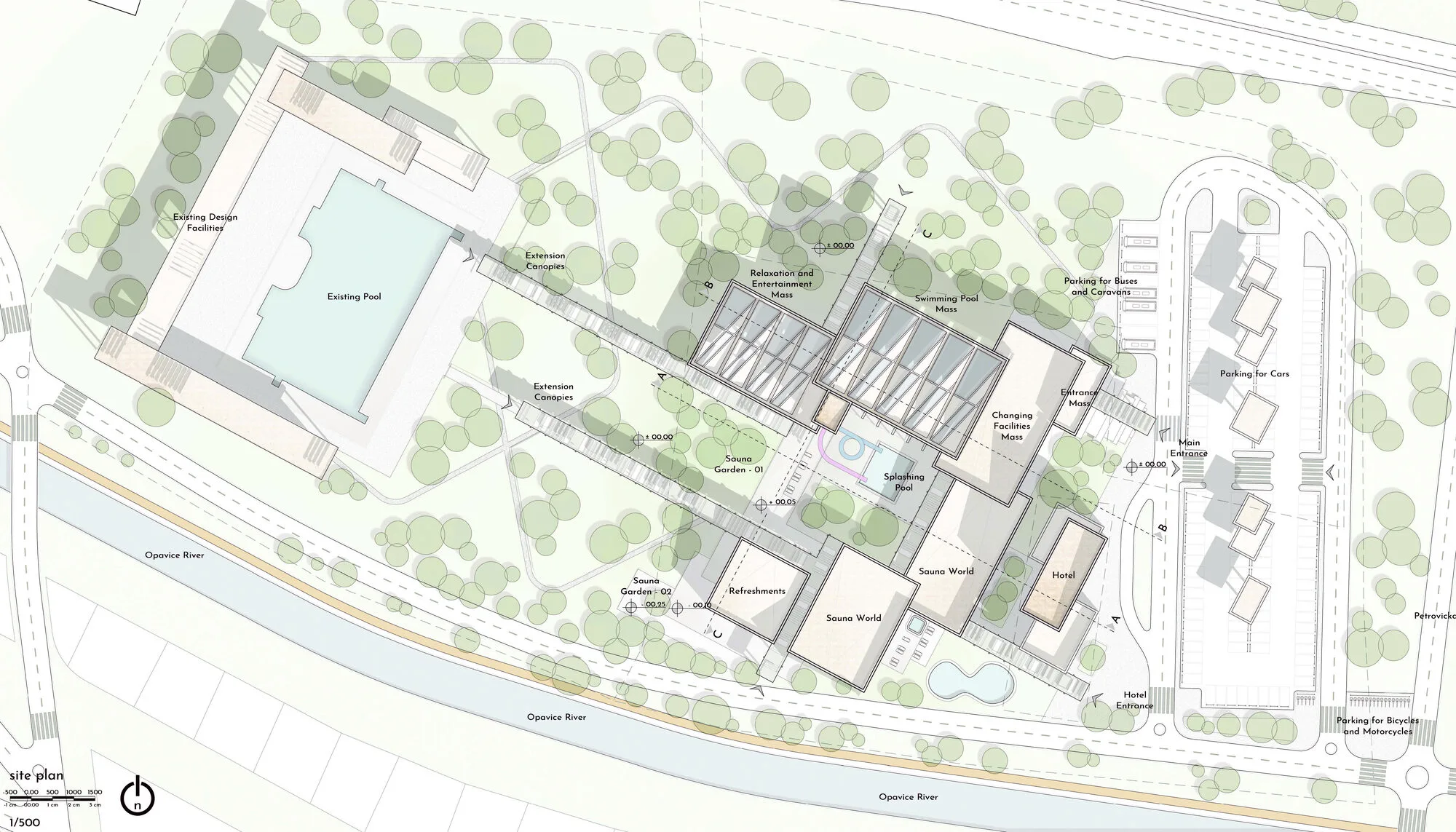
Materiality
It was deemed appropriate to use rammed earth as the primary material of the proposed structure. While selecting this material, the data provided of the project area were considered in detail. One of the most im- portant criteria in the selection of compacted soil is that the transportation and application costs of rammed earth are very low, its thermal conductivity is high, and it offers various prospects to keep the construction ‘’Carbon Footprint’’ at minimum.
At the same time, it is quite permanent and durable and it has been used as a building material for many years in the history of architecture, and its fire resistance feature is one of the featured properties of compacted soil. In addition, the vast increase in climate change, global pollution issues within our globe pushes people to waste less, to produce, save and be more sustainable.
Construction technologies are also trying to use unpolluting energies by renewing themselves in this context. ‘’The Krnov Spa Facility’’ has a masonry structure in which compacted soil is the main building material. In order to increase the statics of the long walls of the building, which is easily built on a rein- forced concrete foundation in the masonry technique with a compact material, horizontal beams are laid at certain levels. On the roof, the skylight roof structure is specifically used in indoor swimming spaces to enhance sunlight gain. The roof setup, on the other hand, was designed based on the broad architectural features of Krnov, Czech Republic and considering the climatic statistics of the city. The intriguing roof form, which was designed with a one-way slope, was also partitioned within itself and the fragmented feeling which is visible from the upper scale view is aimed to be reflected on the outer shell of the building as well. The building design concept and the material are designed to use sustainable energy at the max- imum level. As a consequence of wanting to use waste and excess energy produced at minimum level, the open surfaces of the design are also designed to make maximum use of daylight.
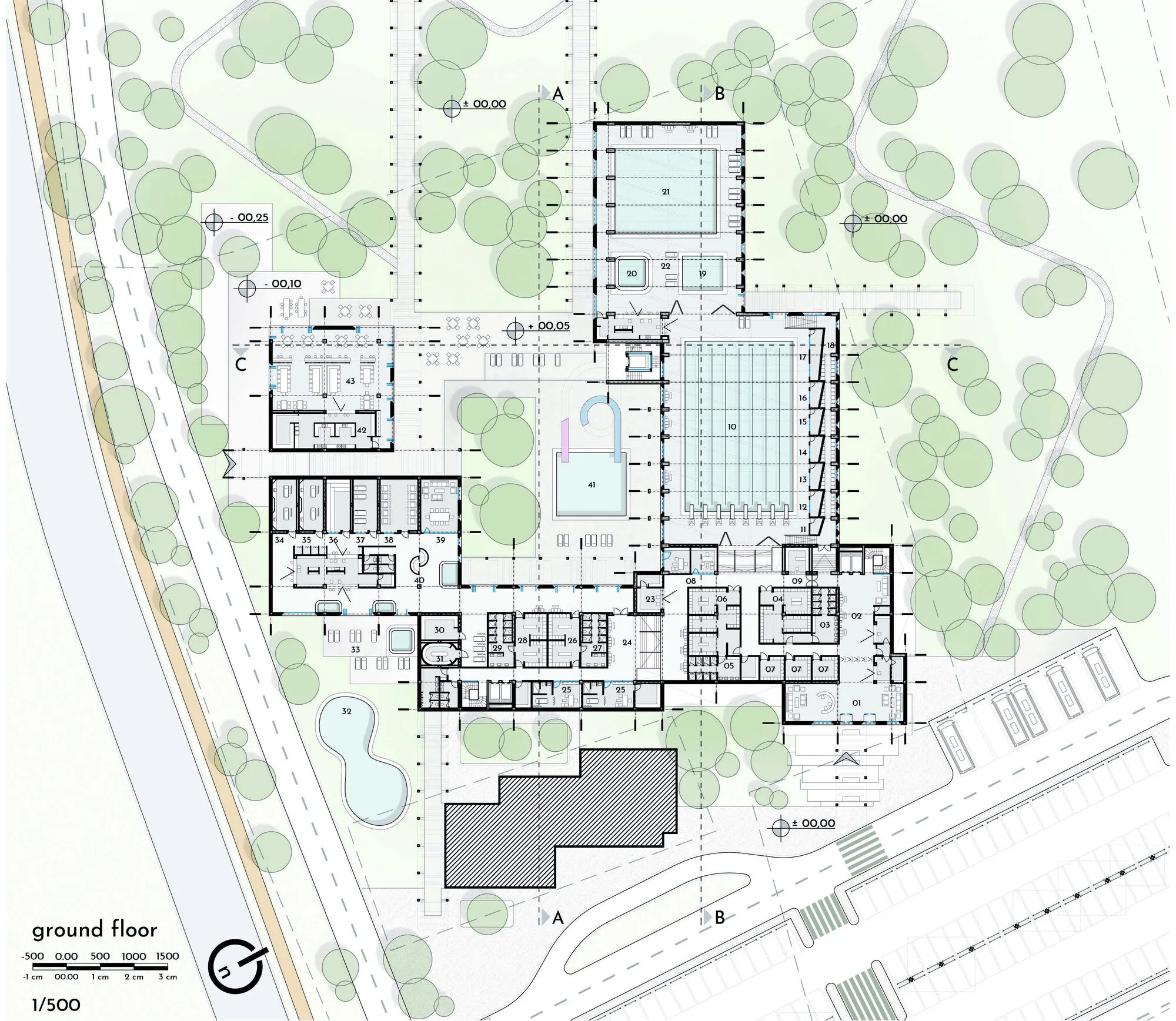
Architectural Fiction
When examining the climatic data of Krnov, the indoor swimming pool area is also one of the main venues therefore, it was decided to be the most prominent box in the design, since it is an area that is expected to be used intensively. It has been designed with a pool and a tribune for spectators and other areas in the program for the use of users coming from the dressing room, which is now stated as a clean feet zone. It has been tried to increase user satisfaction by orienting its façade to the southern face of the inner courtyard. The northern façade of the pool is facing to an impressive green texture. There is a relaxation pool, splash pool and jacuzzi in the Relaxation and Entertainment mass directly connected to this area. This place is de- signed as an area where swimming lessons can be held throughout the year and where children can spend time at the same time.
Sauna World venue has indoor, semi-open and open areas. There are sauna cabins, spa areas, massage areas and a jacuzzi. In this area, users are offered to use this space free from sounds and noises of other places, accompanied by the view of the Opava river and a dense green texture. By creating interior gardens within the space, the relaxing green texture is integrated with the space and function of the Facility.

Distinct from the general design, the roof forms, which are fractrures and sloped, are diversified with sky- lights and it is aimed to make maximum use of daylight in the pool areas. For users who will use the pool areas and need snacks, a vitamin bar has been added to the entertainment and relaxation pool mass to serve both zones. There is a relaxation pool, splash pool and jacuzzi in the Relaxation and Entertainment mass directly connected to this area. This place is designed as an area where swimming lessons can be held throughout the year and where children can spend time at the same time. Distinct from the general design, the roof forms, which are fractrures and sloped, are diversified with skylights and it is aimed to make maxi- mum use of daylight in the pool areas. For users who will use the pool areas and need snacks, a vitamin bar has been added to the entertainment and relaxation pool mass to serve both zones.
The water tower in the inner courtyard is 18 meters high and has two slides. It is a place where users can actively use it and works in direct connection with two pool masses.
Finally, the cafe/restaurant mass is a box that is connected to the mass with reinforced concrete eaves, but also works independently, when examined on the site plan. It is fre- quently used by users who finish off their activities on the riverside or those who only want to benefit from this part of the Facility. By choosing the rammed earth material as the primary material, the construction carbon footprint released to the environment and nature is tried to be kept at minimum level.
